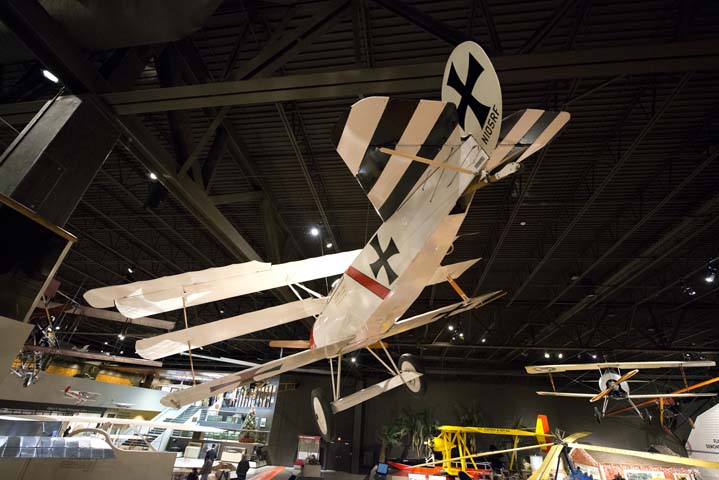Fokker/Redfern Dr. I Triplane Replica - N105RF
Location: Antiques & Classics
EAA’s replica Fokker Dr.I Triplane was built by Walter W. Redfern, EAA 143, and first flown on July 24, 1964. The triplane is arguably the most recognizable fighter of World War I. This example brings the nostalgia and romance of the World War I “knights of the air” to life.
The Fokker Dr.I was flown by many aces of WWI, including the famous Manfred von Richthofen. Although the triplane is closely associated with von Richthofen, very few of his 80 victories were actually flown in a Dr.I. By the time the Dr.I was ready for active service, von Richthofen was the commander of Jagdgeschwader 1 (Fighter Wing 1) with 60 victories to his credit. The “Red Baron,” as von Richthofen was known, flew a blood red triplane. EAA’s triplane is painted in the colors of Lt. Hans Weiss of Jasta 11, part of von Richthofen’s “Flying Circus.”
The engine used in the aircraft was a Le Rhône type 9Ja, nine-cylinder, 120-hp rotary or others based on the Le Rhône design. Being a rotary engine meant that the crankshaft was bolted to the firewall and the propeller was bolted to the engine. Thus the entire engine and propeller would rotate around a stationary crankshaft.
The maximum speed was estimated to be about 115 mph with an endurance of about 90 minutes. The fuselage and empennage are welded steel tubing, the wings are wood, and the airframe is covered with fabric. The Dr.I was armed with two Spandau machine guns that were synchronized with the propeller so that when fired, the bullets would pass through the propeller arc without striking the blades.
In late 1916, the first triplane fighter appeared over the front lines. The aircraft was not a German Fokker but an English Sopwith. The appearance of the English triplane concerned the German Flying Corps enough that they ordered a triplane to be designed to counter the threat. Two manufacturers came up with flyable triplane designs with Fokker winning the production contract. The triplane was not as fast as its opposing ships, but it was untouched in climbing and maneuverability. von Richthofen is quoted as saying, “It climbed like a monkey and maneuvered like the devil.”
A total of 320 Fokker Triplanes were produced during WWI, a much smaller number than its counterparts, such as Camels and SPADs, which were produced in the thousands. No original Dr.I examples still exist, but numerous replicas in varying scales have been built and flown.
Fokker Dr.I Design and Construction
The Fokker Dr.I was designed and built with the standard methods of the time. The fuselage was welded steel tubing with cross wire bracing. Cross wire bracing was key to the design in that it created a very stiff and rugged frame. The sides were covered with plywood sheets and the entire fuselage was covered with fabric.
The wings of the triplane were made mostly of wood. All three wings were of the same basic design and construction. Box spars made of spruce and plywood formed a very strong basis for each wing. Ribs made of pine and plywood were used throughout. The leading edge of each wing was covered with plywood and the entire wing was covered in fabric. The middle wing was unique in that it had cutouts that provided better visibility while operating on the ground. Only the upper wing had ailerons. All of the control surfaces – ailerons, elevator, and rudder – were constructed of fabric-covered welded steel frames. This is also true for the horizontal and vertical stabilizers.
Instruments
The Dr.I instruments were extremely minimal by today’s standards. There was a compass, fuel gauge, and ignition switch. A few models also had a tachometer and an anemometer for airspeed.
Control System
The control system consisted of a control stick, rudder bar, and engine controls. The control stick operated the elevator and ailerons. On top of the stick were two grips. On the right was a fixed wooden grip; on the left, a wooden grip that could be moved fore and aft to throttle the engine. Between the grips was a button to fire one or both of the machine guns. The rudder was a simple pivoting rudder bar with stirrups into which the pilot could strap his feet. On the left side of the cockpit were two engine controls, a carburetor lever, and an auto-release lever. The carburetor lever regulated the flow of the combustion mixture in the carburetor. The auto-release lever could be twisted to control the fuel flow valve located on the fuel tank.
Our replica was ultimately donated to the EAA AirVenture Museum by Robert Fergus.
Aircraft Make & Model: Redfern Fokker Dr.I Triplane Replica
Length: 18 feet 11 inches
Wingspan (upper): 23 feet 7 inches
Wingspan (middle): 20 feet 5 inches
Wingspan (lower): 18 feet 6 inches
Height: 9 feet 8 inches
Empty Weight: 895 pounds
Gross Weight: 1,295 pounds
Seats: 1
Powerplant: Warner Scarab seven-cylinder radial
Horsepower: 145 hp
Maximum Speed: 120 mph
Armament: 2 7.92mm Spandau Light Machine Guns (reproductions)


